Many people face the problem of dry heels. Not only does this phenomenon cause a lot of discomfort, but also the appearance of the legs becomes unattractive. If you want to show off your soft and pink heels, then you need to provide them with gentle care.
Dry heels: cause
Girls love to show off their beautiful legs. On the street, on the beach, in the office, at home - anywhere. However, dry heels can significantly spoil the mood and force beauties to wear closed shoes. The reasons for this unpleasant phenomenon may be the following factors:
- wearing uncomfortable high-heeled shoes;
- lack of vitamins A and E, which affect the condition of the skin;
- fungal infections (in this case, in addition to dryness and cracks, there may be a change in skin color);
- improper foot care and neglect of personal hygiene rules;
- disturbances in the functioning of the endocrine system.
Should you see a doctor?
Dry heels are a fairly common problem. What to do if the problem does not go away over a long period of time? Of course, consult a doctor. The fact is that if the problem of rough skin cannot be solved with the help of cosmetic procedures, then most likely the reason lies in health problems:
- lack of vitamins in the body (both seasonal and chronic);
- fungal diseases;
- problems with the thyroid gland;
- fungus or herpes;
- eczema;
- diabetes mellitus of any type.
If you have any of the above problems, then no cosmetic procedure can cure dry heels and cracked heels. You will have to undergo complex drug treatment.
Softening procedures
Dry heels are a serious problem, but it can be solved. Constant and careful skin care is important. The main thing is that at the first signs of dryness, you need to start intensive therapy, which may include the following procedures:
- Regularly pamper your feet with herbal baths. A combination of chamomile, calendula, string and sage helps to cope with dryness and cracks. It is worth noting that such a procedure has not only a softening, but also an anti-inflammatory effect, which will be an additional prevention of fungus.
- Sea salt or regular table salt is an effective remedy against cracked and peeling skin on the heels. You need to immerse your feet in a warm, concentrated solution for a quarter of an hour. If dryness has reached a critical level or there are deep cracks, then add milk to the bath.
- Red wine has a beneficial effect on the skin. It will not only soften your heels, but also relieve fatigue. For two liters of water you need to take 2 glasses of wine (can be replaced with grape juice). In 20 minutes you won't recognize your heels.
For the effect to be noticeable and lasting, you need to complete the procedures correctly. Feet should be wiped dry and lubricated with moisturizing creams or nourishing oils. You should also wear cotton socks.
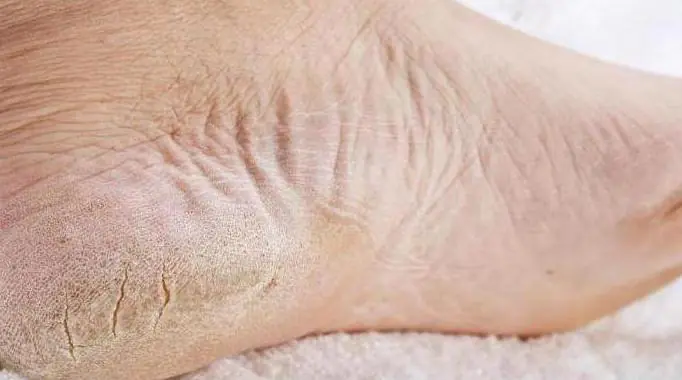
Compresses for dry heels
Due to the fact that the load on the feet and heels is quite large, they quickly lose moisture. As a result, the skin cracks and becomes rough. To revive dry heels, you need to regularly make nourishing compresses. The following recipes work best:
- Onions will help you remove the top rough layer of skin. It needs to be grated on a fine grater, then mixed with a small amount of honey and milk. Apply the resulting pulp to a bandage or gauze, apply it to the heel and wrap it with polyethylene. Put on thick socks on top and leave the compress on overnight. To eliminate the unpleasant onion smell in the morning, wash your feet well with laundry soap and be sure to apply cream.
- Honey is a real salvation for dry skin. They need to lubricate problem areas, cover with plastic and put on warm socks. It is better if the honey compress remains overnight. After you wash your feet in the morning, be sure to apply the cream.
- If the skin is not too rough, then a green apple will help you solve the problem. Rub it into a puree, wrap it in a piece of bandage or gauze and apply it to your heels. You need to secure the compress with plastic bags and socks. It's better to leave it overnight.
- Perhaps the simplest and most effective is a cabbage compress. You just need to knead a clean sheet in your hands or beat it with a rolling pin and apply it to your heel. Secure the compress with a bandage, and the next morning remove and lubricate your feet with cream.
- Celandine is a healing plant that helps to cope with many problems. If you have dry heels, you can make a healing compress at home. Chop a fresh leaf (you can beat it with a rolling pin) and apply it to the problem area. As in previous cases, you need to wrap your feet in polyethylene, put on socks and leave the product on overnight.
Pumice processing
Many people face the problem of cracked or dry heels. What to do? Of course, treat them with pumice. Even though this is the most popular method, many people make mistakes. For example, it is wrong to treat your heels while taking a shower, or immediately after, while they are heavily steamed. It is better to do this about half an hour before swimming. The effect will be more pronounced if you lubricate your heels with a nourishing cream before treating with pumice.
Dry heels - treatment with pharmaceutical products
In the pharmacy you can find many products that are aimed at solving not only medical, but also cosmetic problems. So, if your heel is dry and cracking, then try using the following medications:
- "Five Days" is a nourishing cream with a rich composition, thanks to which your legs will simply be transformed. It has not only nutritional, but also disinfectant properties. Thus, in addition to healing cracks, fungal diseases will also be prevented.
- "Sea Wolf" is an effective budget remedy that fights a lot of problems (from the aggressive effects of water, sun or cold to a lack of vitamins and nutrients). The components of the cream promote rapid regeneration, and therefore your heels will be transformed in the shortest possible time.
- "Bepanten" is a popular remedy that helps cope with skin problems. Thanks to a component such as lanolin, the epidermis softens and cracks heal quickly.
Proven "grandmother's" remedy
Dry fives and cracked feet are a perennial problem. At the moment, in pharmacies and cosmetic stores you can find a lot of products and devices that help cope with it. What did women do in those days when only ineffective pumice was available? There is one effective recipe.
Buy a bottle of glycerin, as well as vinegar essence. This is all you need to prepare the product. The glycerin container will not be full. You need to add vinegar essence to the neck, close it tightly, and then shake vigorously.
Wash your feet well with laundry soap, steam them in a bath (you can use herbal or salt water) and rub thoroughly with a pedicure brush to remove the top layer of rough skin. Now you need to dry your skin with a towel.
Shake the bottle with glycerin and vinegar essence thoroughly, soak a cotton swab in the liquid and treat all the roughness that is on the feet, paying special attention to the heels. Next, you need to put cellophane bags and thick socks on your feet. It is best to do the procedure at night. But if you decide to do it during the day, then rest assured that the composition will be absorbed into the skin in about 40 minutes. After the procedure, you can lightly rub your heels with pumice, but this is not necessary. Wash your feet with soap and lubricate them with cream.
If your heels are in a bad state, then at first the procedure will have to be carried out daily until the skin returns to normal. After this, once a week will be enough to maintain the effect.
Preventive measures
Dry heels and cracks can cause ladies not only physical, but also aesthetic discomfort. Naturally, preventing a problem is much easier than dealing with it later. Preventive measures include the following:
- try to wear comfortable shoes, and also use special gel insoles;
- do not neglect the rules of personal hygiene - wash your feet daily using antibacterial agents;
- regularly use pumice stones, as well as scrubs (store-bought or homemade);
- before going to bed, lubricate clean feet with moisturizing creams or nourishing oils;
- Periodically take a course of vitamins A and E, and also include foods containing them (carrots, apples, grapes, etc.) in your diet.
conclusions
Dry skin on the heels, cracks - all this does not add beauty to your feet. Unfortunately, many women do not pay enough attention to this problem, which can lead to quite serious consequences. If you want to be on top in any situation, if you like to wear open shoes, and also if you want to become the queen of the beach, then your feet need regular and high-quality care. Do not neglect the rules of personal hygiene, monitor your health and nutrition, and regularly pamper your feet with herbal baths and natural peelings.
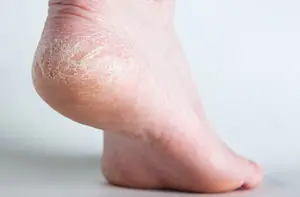
Dry skin on the heels is a nuisance that affects both women and men. She causes a lot of inconvenience. And the point here is not only that the foot looks extremely unattractive. This defect interferes with walking and can be the result of serious health problems. Therefore, it is very important to know the whole truth about dry heels, the causes and treatment of this problem.
Causes of dry heels
Many people experience keratinization of the skin on their feet and heels. This is not always related to age. The answer to the question is Why your heels are dry and cracking depends on factors such as:
- Wrong choice of shoes. This option is the most common, affecting mainly female representatives. When choosing shoes, they are guided not by convenience, but by the beauty of the model, often wearing shoes that are too tight, only to make the feet appear smaller. But if the shoes don’t fit your feet, the load on all parts of the foot increases several times. The quality of the material is also of great importance. If it is not natural, the skin hardly breathes. It becomes denser and corns form. The heels become rough, and if nothing is done, they begin to crack and hurt.
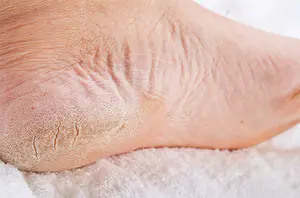
Lack of regular foot care. Spending a lot of money and time on getting their face, hands and body in order, many people don’t even remember about their feet. At best, everything is limited to a pedicure, although the skin of the feet and especially the heels requires daily attention and care. It also needs to be moisturized, cleaned and protected.- Lack of vitamins. If the body does not receive its norm of nutrients, this also affects the heels. They can crack in the absence of vitamins A, B, C and E, so you should not forget about them.
- Presence of diseases. There are a number of diseases that affect the condition of the skin of the feet. Among them are fungal infections, eczema, dermatitis, diabetes, and thyroid problems. Dry feet and heels can be caused by pregnancy, hormonal imbalance or menopause. Those suffering from diabetes should be especially careful. If not properly cared for, they may lose a foot or part of it.
Everyone should monitor their health. After all, if problems arise due to a lack of necessary vitamins or your heels become dry due to illness, even the best foot care will not help. Any disease must be treated as early as possible.
Stages of foot skin care
The skin of this part of the body, like any other, requires an integrated approach. Only in this case can you expect a quick and good result. Here are the most important parts that make up Recommended care program:
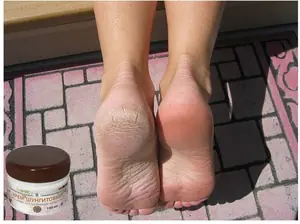
Cleansing. It all starts with him. It is useless to apply various cosmetics to dirty skin; it will not give the desired effect. You should at least wash it with soap, or you can make a special bath. Cleaning with a scrub is recommended once a week. To remove old skin, it is better to use a pumice stone or a brush;- Hydration. At this stage, all kinds of moisturizing creams are used, which are widely available in stores. If necessary, they can be easily replaced with any vegetable oil or vitamins A and E in liquid form;
- Nutrition. Ready-made store-bought products are also perfect for these purposes, or you can also use proven folk recipes.
All procedures are usually carried out in the evening shortly before bedtime, so that the skin can rest and absorb all the beneficial substances overnight.
Heel care products and tools
Helping your heels is very easy. For these purposes, they sell a lot of special products in any price category. You can also resort to folk recipes, which are also quite effective.
Pharmacy drugs
In any pharmacy today you can buy creams, sprays and ointments to improve the condition of the skin of the feet and combat rough heels.
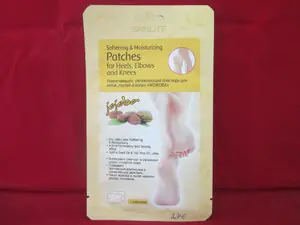
These include:
- Sea Wolf cream. It will help eliminate cracks that have formed and fight inflammation;
- ointment or cream "Panthenol". Will soften rough heels and help quickly heal fresh calluses;
- ointment "Radevit". Thanks to vitamins A, E and D, it accelerates regeneration processes and nourishes the skin. Suitable also for prevention.
A hardware pedicure, which can be done in many salons and clinics, would also be useful. This cosmetic procedure not only tidies up the nails, but also removes calluses and softens and smoothes the skin on the heels.
Folk remedies
If your heels are cracking, everyone should know what to do at home. Traditional medicine has a variety of methods and recipes that are time-tested and effective. Here are just a few of them:
- salt bath for steaming. To do this, you need to dilute 50 g of salt in warm water, soak your feet there for 15 minutes and get rid of rough skin using pumice. In advanced cases, you can do the procedure every evening, and then once a week will be enough;
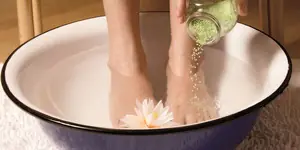
all kinds of compresses. Done at night. For them, some substance is applied to the skin of the heels, the foot is wrapped in cling film, and cotton socks are put on top. In the morning, the remnants of the compress are washed off with warm water and, if necessary, a nourishing cream is applied. For these purposes, you can use olive oil or a mixture of chopped onion with a tablespoon of milk;- rice scrub It will help to better cleanse the skin and remove dead cells. To prepare it, you need to take 1 tablespoon each of coarsely ground rice, almond oil, apple cider vinegar and honey and mix well. Pre-steamed skin is treated with the mixture, after which it is washed off and a nourishing cream is applied;
- egg mask. Prepared from egg yolk, half a teaspoon of starch and a teaspoon of lemon juice. After applying the mask to the skin of the heels, you need to wait for it to dry completely and form a crust. Then the mixture is washed off and the skin is treated with moisturizer.
To properly care for your feet, you need to have a piece of pumice or a sanding file at home. Under no circumstances should thickenings be cut off with a razor. This can damage the skin and lead to infection through the wounds. Even if this does not happen, after such removal of the skin it becomes much denser, the heel condition is only getting worse.
When processing with pumice, all movements are carried out in one direction, otherwise the skin will not become smooth. You also need to choose the force of pressure carefully. If you overdo it, you can get hurt.
After the procedure is completed, the foot must be lubricated with cream or other nourishing agent.
Preventive measures
It is always easier to prevent a problem from occurring than to fight it. This also applies to dry feet. To keep your heels soft and smooth The following rules must be observed:
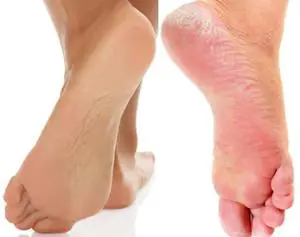
Buy and wear only high-quality shoes of the appropriate size. It is advisable to choose socks only from natural materials;- Take care of your feet regularly. Wash them daily, treat them with pumice and scrub once a week, sometimes make masks and baths, apply a nourishing and moisturizing cream in the evening;
- Include vitamins and foods rich in polyunsaturated fatty acids and beneficial microelements in your diet.
If you are still worried about such a nuisance as dry heels, you must not forget what to do at home in this case. The comprehensive use of heel skin care products will help heal them and soon forget about this inconvenience.
Many people notice that their heels have very dry skin and don't know what to do if their heels are cracking.
This causes discomfort and sometimes pain when walking.
The causes and treatment methods for dry skin on the heels discussed below will help you deal with this problem.
Reasons why the skin on the heels becomes very dry, rough and cracked
Uncomfortable shoes
This is one of the most common causes of rough feet. If you are familiar with the situation when the shoes of your dreams are a size too small or “very comfortable to fit in,” but you still wear them, then this is your case. When wearing uncomfortable or poor-quality shoes, the load on the feet, and especially the heels, increases.
Low-quality synthetic materials do not allow the skin to breathe. This leads to thickening of the skin and the appearance of corns. The heels become rough and rough to the touch. In advanced cases, cracks form, sometimes very deep, causing pain when walking.
Insufficient care
We are accustomed to paying attention first of all to our face, hands, then our body, and, last but not least, our feet - mainly our fingers and nails. Heels are often left without proper care. Few people apply sunscreen to them on the beach; few people think about their condition in open shoes in hot or windy weather. In the end, We are used to applying care products to our face and hands every night before going to bed, but much less often to our feet.
Lack of vitamins and minerals
The skin of our entire body experiences the consequences of vitamin deficiency, iron deficiency and a lack of various microelements. Because of this, skin problems can occur seasonally or constantly if the body does not receive any vitamin therapy.
Some diseases
Dry skin can primarily be caused by many dermatological diseases. And at the top of the list of these diseases is a fungus. It is followed by eczema, dermatitis, and allergic reactions. All of them are accompanied by additional severe peeling, deep cracks, itching, and blisters. If they are present, it is recommended to visit a dermatologist.
Hormonal diseases, pregnancy and menopause, diabetes mellitus dry out the skin of the feet.
IMPORTANT! Diabetics are advised to take extreme care of the skin of their feet due to the risk of developing diabetic foot.
Basic care recommendations
Heel care should begin with cleansing.. For this, it is good to use various baths, but you can limit yourself to a regular bath or shower. The stratum corneum of the skin should be removed regularly with a brush or pumice stone. It’s good to use a scrub several times a month.
You can use any creams to moisturize., available in large quantities on store shelves. If you are a supporter of natural care products, you can replace them with vegetable oil (olive, almond and others) or vitamins A and E in capsules.
The third link in the care chain is nutrition. You won’t have to look for long for nourishing creams and balms either. But it should be emphasized that it is also important to balance the diet, because vitamins and nutrients must enter the body with food. It is recommended to include fish, vegetable oils, and nuts in the diet.
It is recommended to apply the cream to the skin of the feet daily before bed.
How to get rid of dry skin on your heels?
You can turn to folk remedies, medications and salon services. Let's take a closer look at them.
Folk remedies
Baths
Steam baths are one of the most effective treatment methods. With very rough skin, they can be done daily, and when the heels return to normal, once a week will be enough.
Bath recipes
- Saline. Dissolve 50 g of salt in hot water (both sea salt and regular table salt are suitable). Keep your feet in the bath for 15 minutes, and then gently treat them with pumice.
- Herbal. Pour 3-4 tablespoons of dried herbs - chamomile, calendula, sage, string - into a liter of boiling water and leave for an hour. Then add water and heat it up a little. You need to take a bath for 20-25 minutes. This recipe is good for painful cracks. The aroma of dry herbs additionally has a relaxing effect.
- Wine. Mix 0.5 liters of red wine or grape juice with two liters of hot water (40-45 degrees). Keep your feet in the solution for 20 minutes. This bath softens the skin and restores strength.
Compresses
This is also a very effective method of treating dry heels. Compresses can be easily prepared at home, and the result will be soft, well-groomed feet.
Compress recipes
- With hydrogen peroxide. Mix peroxide with warm water in a ratio of 1:5. Soak gauze with the resulting solution and apply it to the feet, wrapped in cellophane. Keep the compress for 2 hours, then apply nourishing cream to the heels.
- Onion. Grind the onion to a pulp and mix with 1 tbsp. milk. Spread the mixture over problem areas and wrap with cling film. Put socks on top and leave overnight. In the morning, wash off the compress and lubricate your heels with cream.
- Cabbage-honey. It is recommended to do it after a bath. Apply honey to the heels, cover with cabbage leaves, wrap with cling film and leave overnight. In the morning, wash your feet with warm water.
- Oil. One of the best softening oils for heels is olive oil. It should be applied to the heels and rubbed in a little. Put on cotton socks and leave overnight.
Scrubs
Scrubs and peels prepared independently will help get rid of dead cells. The effect of the scrubs will be enhanced if you first soak your feet in the bath.
Scrub recipes
Sugar. To one small cup of tea (medium brew) add 3 tbsp sugar, 2 tsp. coconut oil, juice of half a lemon. Stir quickly so that the sugar does not dissolve. Apply to the heels and rub the mixture with massage movements for several minutes. Rinse off with warm water. Rice. 1 tbsp. Grind the rice (not very finely). Mix with 1 tbsp. almond oil, honey and apple cider vinegar. Treat the steamed skin with the resulting mixture, rinse and apply cream. Coffee. 1 tsp ground coffee, 1 tsp. salt mixed with 2 tbsp. vegetable oil. Apply the scrub after the bath using massage movements. Rinse off with warm water.IMPORTANT! This product should not be abused by those with white skin - coffee gives it a tan tint.
Foot masks
Masks for the skin of the feet are as effective as for the face. But rarely anyone makes them, since they are not so popular.
Egg
1 egg yolk, ½ tsp. starch, 1 tsp. Mix lemon juice until smooth. Apply to the skin of the heels after the bath and leave until dry. Then rinse and apply moisturizer.
Clay
Dilute blue, white or pink clay with milk or water until it becomes liquid sour cream. Apply to prepared feet and leave until dry. Rinse with warm water, apply emollient cream.
Honey
Mix honey and cottage cheese in equal proportions to a paste. Apply to feet for 20 minutes. To enhance the effect, you can wrap your feet with film and put on warm socks. Rinse off with warm water.
Medicines
Modern clinics provide patients with the service of hardware pedicure - this is not a decorative decoration of nails, as we are accustomed to understanding, but the treatment of feet and nails with a special device. During this procedure, the specialist removes corns, the skin becomes soft and smooth. Some beauty salons (where there is a cosmetologist) also perform the same procedure.
Pharmacies offer a wide range of different foot skin care products: creams, ointments, sprays. The “Sea Wolf” anti-crack cream, which is made from natural ingredients, is very popular. It is also good at fighting inflammation. For cracks and severe peeling Bepanten or Panthenol cream and ointment help well. The healing and softening effect is visible after just a few uses, making this product well suited for treating fresh calluses.
Pumice
Treating heels with pumice stone has already become a classic means of caring for heels. Before this procedure, the heels need to be steamed well.
ATTENTION! Rub the skin with a pumice stone in one direction.
It is best to use natural pumice of medium porosity. But if your skin is very dry, you can treat your heels with a fine-pored stone.
Salon treatments
Pedicure is one of the most popular services in beauty salons. A hardware pedicure gives very good results, but an experienced specialist can achieve ideal smoothness of the skin manually. In addition to pedicures, massage services, peelings, masks and other SPA treatments can be provided.
IMPORTANT! The salon may refuse to provide services if there is a fungus on your feet. If you suspect a fungal infection, you should consult a dermatologist.
Prevention
Only proper care and respect for your legs will ensure their decent appearance. It is enough to follow only a number of simple rules to forget about the problem of dry heels:
- choose quality shoes in your size;
- Carry out regular foot care: treat with pumice and take baths once every 1-2 weeks and apply cream daily;
- Make sure you have enough vitamins, minerals and amino acids in your diet.
Dry foot skin and cracked heels are a very common problem, but they are quite easy to get rid of with a little effort. If you want your heels to always look perfect, use simple recipes several times a month, and you won’t even remember about dry heels.



